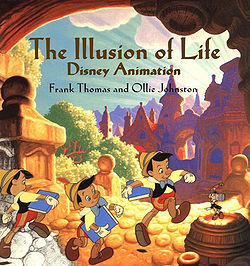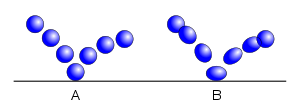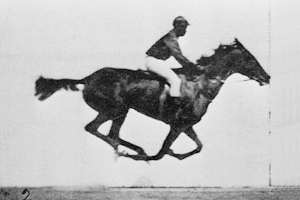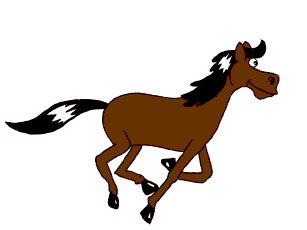
12 basic principles of animation
Encyclopedia

Animation
Animation is the rapid display of a sequence of images of 2-D or 3-D artwork or model positions in order to create an illusion of movement. The effect is an optical illusion of motion due to the phenomenon of persistence of vision, and can be created and demonstrated in several ways...
introduced by the Disney
The Walt Disney Company
The Walt Disney Company is the largest media conglomerate in the world in terms of revenue. Founded on October 16, 1923, by Walt and Roy Disney as the Disney Brothers Cartoon Studio, Walt Disney Productions established itself as a leader in the American animation industry before diversifying into...
animator
Animator
An animator is an artist who creates multiple images that give an illusion of movement called animation when displayed in rapid sequence; the images are called frames and key frames. Animators can work in a variety of fields including film, television, video games, and the internet. Usually, an...
s Ollie Johnston
Ollie Johnston
Oliver Martin Johnston, Jr. was an American motion picture animator. He was one of Disney's Nine Old Men, and the last surviving at the time of his death. He was recognized by The Walt Disney Company with its Disney Legend Award in 1989...
and Frank Thomas
Frank Thomas (animator)
Franklin M. "Frank" Thomas was an American animator. He was one of Walt Disney's team of animators known as the Nine Old Men....
in their 1981 book The Illusion of Life: Disney Animation. Johnston and Thomas in turn based their book on the work of the leading Disney animators from the 1930s onwards, and their effort to produce more realistic animations. The main purpose of the principles was to produce an illusion of characters adhering to the basic laws of physics
Physical law
A physical law or scientific law is "a theoretical principle deduced from particular facts, applicable to a defined group or class of phenomena, and expressible by the statement that a particular phenomenon always occurs if certain conditions be present." Physical laws are typically conclusions...
, but they also dealt with more abstract issues, such as emotional timing and character appeal.
The book and its principles have become generally adopted, and have been referred to as the "Bible of animation." In 1999 the book was voted number one of the "best animation books of all time" in an online poll. Though originally intended to apply to traditional, hand-drawn animation
Traditional animation
Traditional animation, is an animation technique where each frame is drawn by hand...
, the principles still have great relevance for today's more prevalent computer animation
Computer animation
Computer animation is the process used for generating animated images by using computer graphics. The more general term computer generated imagery encompasses both static scenes and dynamic images, while computer animation only refers to moving images....
.
The 12 principles

Squash and stretch

Squash and stretch
Squash and stretch is a common animation technique applied to characters or objects in motion. The technique makes their actions more fluid, and it is generally exaggerated for a cartoonish effect. When utilized with more subtlety, it works just as well for realistic movements...
", the purpose of which is to give a sense of weight and flexibility to drawn objects. It can be applied to simple objects, like a bouncing ball, or more complex constructions, like the musculature of a human face. Taken to an extreme point, a figure stretched or squashed to an exaggerated degree can have a comical effect. In realistic animation, however, the most important aspect of this principle is the fact that an object's volume does not change when squashed or stretched. If the length of a ball is stretched vertically, its width (in three dimensions, also its depth) needs to contract correspondingly horizontally.
Anticipation
Anticipation is used to prepare the audience for an action, and to make the action appear more realistic. A dancer jumping off the floor has to bend his knees first; a golfer making a swing has to swing the club back first. The technique can also be used for less physical actions, such as a character looking off-screen to anticipate someone's arrival, or attention focusing on an object that a character is about to pick up.
Staging
This principle is akin to stagingStaging (theatre)
Staging is the process of selecting, designing, adapting to, or modifying the performance space for a play or film. This includes the use or absence of stagecraft elements as well as the structure of the stage and its components....
as it is known in theatre
Theatre
Theatre is a collaborative form of fine art that uses live performers to present the experience of a real or imagined event before a live audience in a specific place. The performers may communicate this experience to the audience through combinations of gesture, speech, song, music or dance...
and film
Film
A film, also called a movie or motion picture, is a series of still or moving images. It is produced by recording photographic images with cameras, or by creating images using animation techniques or visual effects...
. Its purpose is to direct the audience's attention, and make it clear what is of greatest importance in a scene; what is happening, and what is about to happen. Johnston and Thomas defined it as "the presentation of any idea so that it is completely and unmistakably clear", whether that idea is an action, a personality, an expression or a mood. This can be done by various means, such as the placement of a character in the frame, the use of light and shadow, and the angle and position of the camera. The essence of this principle is keeping focus on what is relevant, and avoiding unnecessary detail.
Straight ahead action and pose to pose
These are two different approaches to the actual drawing process. "Straight ahead action" means drawing out a scene frame by frame from beginning to end, while "pose to pose" involves starting with drawing a few key frames, and then filling in the intervals later. "Straight ahead action" creates a more fluid, dynamic illusion of movement, and is better for producing realistic action sequences. On the other hand, it is hard to maintain proportions, and to create exact, convincing poses along the way. "Pose to pose" works better for dramatic or emotional scenes, where composition and relation to the surroundings are of greater importance. A combination of the two techniques is often used.Computer animation removes the problems of proportion related to "straight ahead action" drawing; however, "pose to pose" is still used for computer animation, because of the advantages it brings in composition. The use of computers facilitates this method, as computers can fill in the missing sequences in between poses automatically. It is, however, still important to oversee this process, and apply the other principles discussed.
Follow through and overlapping action
These closely related techniques help render movement more realistic, and give the impression that characters follow the laws of physicsPhysical law
A physical law or scientific law is "a theoretical principle deduced from particular facts, applicable to a defined group or class of phenomena, and expressible by the statement that a particular phenomenon always occurs if certain conditions be present." Physical laws are typically conclusions...
. "Follow through" means that separate parts of a body will continue moving after the character has stopped. "Overlapping action" is the tendency for parts of the body to move at different rates (an arm will move on different timing of the head and so on). A third technique is "drag", where a character starts to move and parts of him take a few frames to catch up. These parts can be inanimate objects like clothing or the antenna on a car, or parts of the body, such as arms or hair. On the human body, the torso is the core, with arms, legs, head and hair appendices that normally follow the torso's movement. Body parts with much tissue, such as large stomachs and breasts, or the loose skin on a dog, are more prone to independent movement than bonier body parts. Again, exaggerated use of the technique can produce a comical effect, while more realistic animation must time the actions exactly, to produce a convincing result.
Thomas and Johnston also developed the principle of the "moving hold". A character not in movement can be rendered absolutely still; this is often done, particularly to draw attention to the main action. According to Thomas and Johnston, however, this gave a dull and lifeless result, and should be avoided. Even characters sitting still can display some sort of movement, such as the torso moving in and out with breathing.
Slow in and slow out
The movement of the human body, and most other objects, needs time to accelerate and slow down. For this reason, animation looks more realistic if it has more drawings near the beginning and end of an action, emphasizing the extreme poses, and fewer in the middle. This principle goes for characters moving between two extreme poses, such as sitting down and standing up, but also for inanimate, moving objects, like the bouncing ball in the above illustration.Arcs
Most natural action tends to follow an arched trajectoryTrajectory
A trajectory is the path that a moving object follows through space as a function of time. The object might be a projectile or a satellite, for example. It thus includes the meaning of orbit—the path of a planet, an asteroid or a comet as it travels around a central mass...
, and animation should adhere to this principle by following implied "arcs" for greater realism. This can apply to a limb moving by rotating a joint, or a thrown object moving along a parabolic
Parabola
In mathematics, the parabola is a conic section, the intersection of a right circular conical surface and a plane parallel to a generating straight line of that surface...
trajectory. The exception is mechanical movement, which typically moves in straight lines.
As an object's speed and momentum increases, arcs tend to flatten out in moving ahead and broaden in turns. In baseball, a fastball would tend to move in a straighter line than other pitches; while a figure skater moving at top speed would be unable to turn as sharply as a slower skater, and would need to cover more ground to complete the turn.
An object in motion that moves out of its natural arc for no apparent reason will appear erratic rather than fluid. Therefore when animating (for example) a pointing finger, the animator should be certain that in all drawings in between the two extreme poses, the fingertip follows a logical arc from one extreme to the next. Traditional animators tend to draw the arc in lightly on the paper for reference, to be erased later.

Secondary action
Adding secondary actions to the main action gives a scene more life, and can help to support the main action. A person walking can simultaneously swing his arms or keep them in his pockets, he can speak or whistle, or he can express emotions through facial expressions. The important thing about secondary actions is that they emphasize, rather than take attention away from the main action. If the latter is the case, those actions are better left out. In the case of facial expressions, during a dramatic movement these will often go unnoticed. In these cases it is better to include them at the beginning and the end of the movement, rather than during.Timing
Timing refers to the number of drawings or frames for a given action, which translates to the speed of the action on film. On a purely physical level, correct timing makes objects appear to abide to the laws of physics; for instance, an object's weight decides how it reacts to an impetus, like a push. Timing is critical for establishing a character's mood, emotion, and reaction. It can also be a device to communicate aspects of a character's personality.Exaggeration
Exaggeration is an effect especially useful for animation, as perfect imitation of reality can look static and dull in cartoons. The level of exaggeration depends on whether one seeks realism or a particular style, like a caricature or the style of an artist. The classical definition of exaggeration, employed by Disney, was to remain true to reality, just presenting it in a wilder, more extreme form. Other forms of exaggeration can involve the supernatural or surreal, alterations in the physical features of a character, or elements in the storyline itself. It is important to employ a certain level of restraint when using exaggeration; if a scene contains several elements, there should be a balance in how those elements are exaggerated in relation to each other, to avoid confusing or overawing the viewer.Solid drawing
The principle of solidSolid geometry
In mathematics, solid geometry was the traditional name for the geometry of three-dimensional Euclidean space — for practical purposes the kind of space we live in. It was developed following the development of plane geometry...
drawing means taking into account forms in three-dimensional space, giving them volume and weight. The animator needs to be a skilled draughtsman
Draughtsman
A draughtsman or draftsman , is a person skilled in drawing, either:*drawing for artistic purposes, or*technical drawing for practical purposes such as architecture or engineering...
and has to understand the basics of three-dimensional shapes, anatomy, weight, balance, light and shadow, etc. For the classical animator, this involved taking art classes and doing sketches from life. One thing in particular that Johnston and Thomas warned against was creating "twins": characters whose left and right sides mirrored each other, and looked lifeless. Modern-day computer animators draw less because of the facilities computers give them, yet their work benefits greatly from a basic understanding of animation principles, and their additions to basic computer animation.
Appeal
Appeal in a cartoon character corresponds to what would be called charismaCharisma
The term charisma has two senses: 1) compelling attractiveness or charm that can inspire devotion in others, 2) a divinely conferred power or talent. For some theological usages the term is rendered charism, with a meaning the same as sense 2...
in an actor. A character who is appealing is not necessarily sympathetic — villains or monsters can also be appealing — the important thing is that the viewer feels the character is real and interesting. There are several tricks for making a character connect better with the audience; for likable characters a symmetrical or particularly baby-like face tends to be effective. A complicated or hard to read face will lack appeal, it may more accurately be described as 'captivation' in the composition of the pose, or the character design.
Further reading
- See also list of best animation books at Animation World NetworkAnimation World NetworkAnimation World Network is an organization for animators, with an extensive website with news, articles and links for professional animators and animation fans. AWN also publishes a printed journal, "Animation World"....
.

